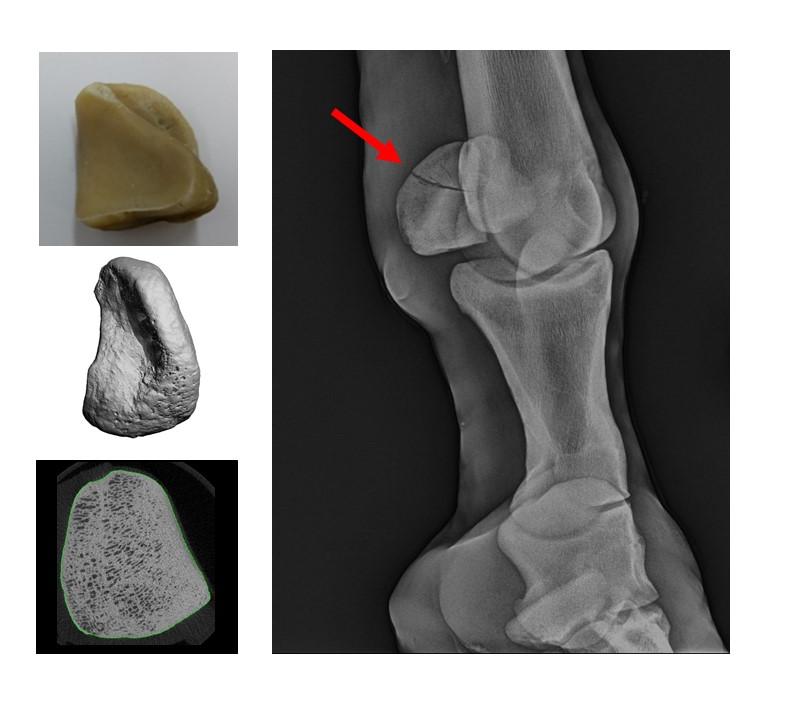MacLeod Highlights Sesamoid Bone Maturation at 2021 UK Equine Research Showcase

The University of Kentucky hosted the first session of its 10th annual UK Equine Research Showcase in a virtual setting Jan. 5. The session emphasized musculoskeletal topics in weanling to yearling horses and presented both completed and work-in-progress projects.
James MacLeod, VMD, PhD, director of UK Ag Equine Programs and John S. and Elizabeth A. Knight chair at the Gluck Equine Research Center, rounded out the evening with a talk on sesamoid bone maturation and research underway in his laboratory and with collaborators.
It’s an important topic, he said, as proximal sesamoid bone fractures are associated with 40-50% of all fatal catastrophic injuries in Thoroughbred racehorses.
He and the graduate students in his laboratory are in the initial phases of research and starting with a look at what is normal vs. not normal with respect to equine proximal sesamoid bones. That step will help lead to an understanding about how the development processes change with high speed exercise.
According to MacLeod, very little research currently exists about sesamoid bone development. His team hopes to fill in those gaps. The questions they will be asking as they get underway are: How does the structure of proximal sesamoid bones change in response to high speed exercise (racing and other activities)? And can that information be interpreted to determine if there are abnormal structural changes that occur in proximal sesamoid bones that precede failure (fracture)?
According to MacLeod, in order to answer those questions, his team first needs to know what is normal in size, shape and microstructure; how much variation occurs in healthy bones between individual horses; and what biological variation in age, gender and breed occurs.
As part of this explanation, MacLeod also provided attendees a primer about sesamoid bones.
Sesamoid bones, usually small and triangular in shape, are embedded within a tendon or ligament. They function to absorb and redistribute forces, decrease friction and protect and enhance the power production of connected muscles.
We are familiar with them ourselves. In people, the patella in our kneecaps are examples of sesamoid bones, as are the bones in our feet at the metatarsal junction at the base of our toes.
MacLeod explained that sesamoid bones function as a fulcrum, allowing us, for example, to extend the bottom of our leg from our knees.
The horse has three sets of sesamoid bones. There are two patella, one in each stifle joint –the true knee of the horse in comparison to human anatomy. The navicular bone (sometimes called the distal sesamoid bone) is the second, located in each hoof underneath the flexor tendon. Finally, the proximal sesamoid bones, one medial and one lateral, are found in each fetlock joint. Since horses have four legs (four fetlocks), each horse has a total of eight proximal sesamoid bones.
As MacLeod and researchers in his lab begin their research, they will assemble a sample set of proximal sesamoid bones that reflects normal development and maturation. They’ll study them as complete bones, then structurally, then ultra-structurally using CT (computed tomography) imaging. One of the things they’ll measure through this process is bone volume compared to total volume of the structure. They’ll also look at parameters for the number and thickness of trabeculae within the inner bone meshwork, and their anisotrophic or isotrophic structural organization. (Isotropic means the structure is the same in every direction, like glass. Anisotrophic is nonhomogeneous, like wood, where the grain alters how it can split apart). The internal organization of trabeculae is frequently an important parameter in the structural and biomechanical properties of a bone.
“With proximal sesamoid bones, a much better baseline understanding of what is normal as a function of age, gender, breed and the individual horse’s size is needed in order to characterize how these small but critical bones remodel in response to high intensity exercise,” MacLeod said. “Our goal with this project is to facilitate research efforts by our group and others around the world trying to develop sensitive ways to detect proximal sesamoid bones at risk of fracture before a catastrophic injury occurs.”
Holly Wiemers, MA, APR, is the communications and managing director for UK Ag Equine Programs.
